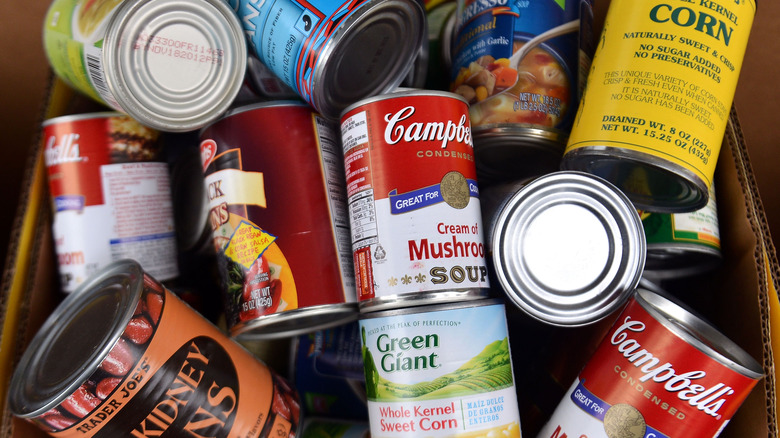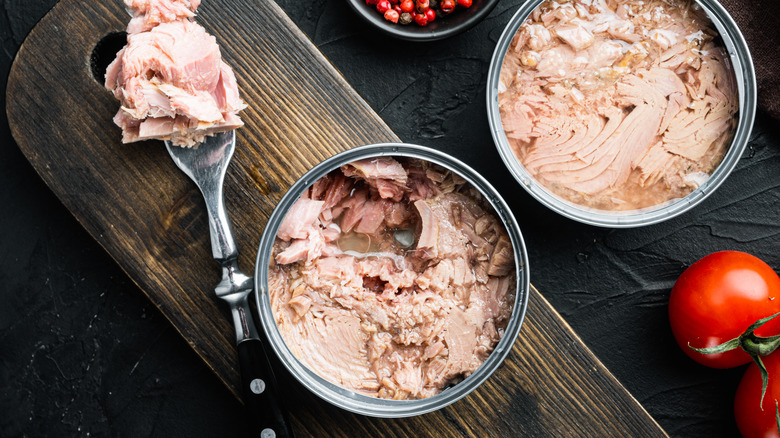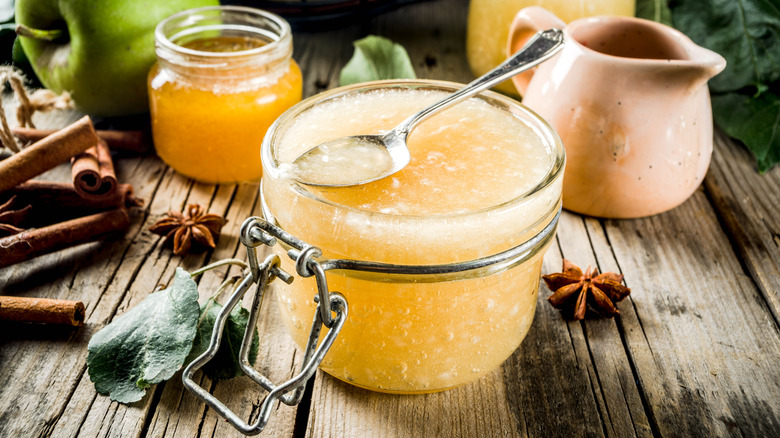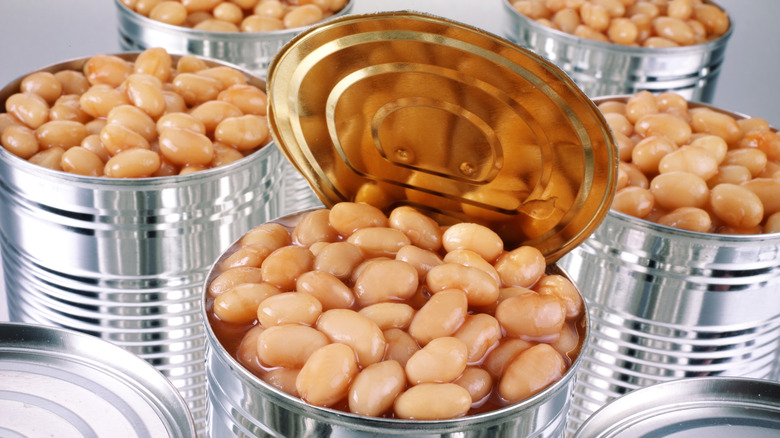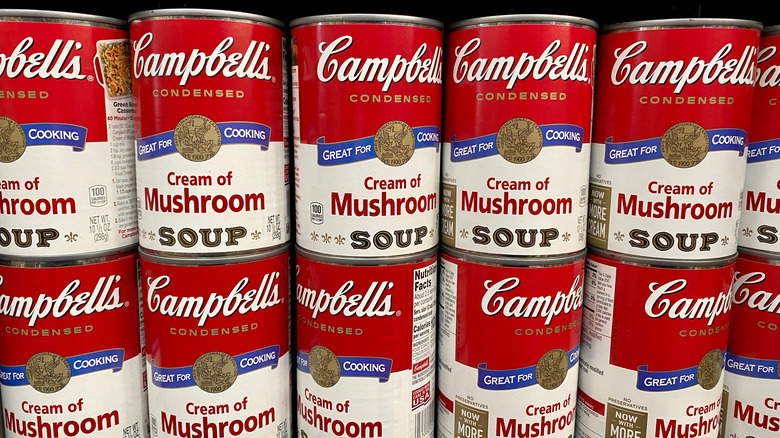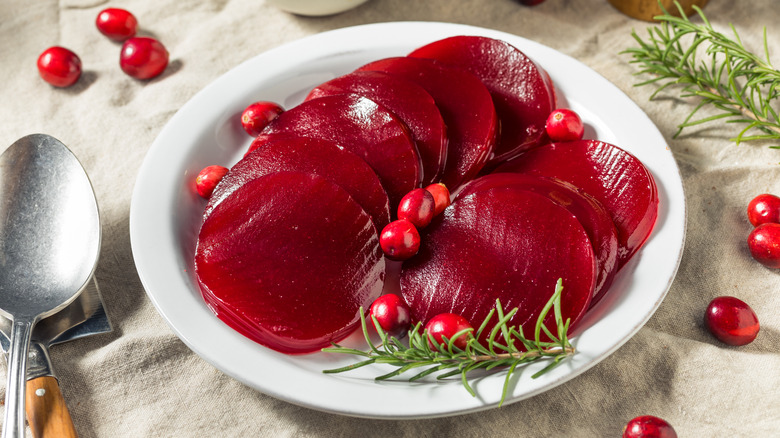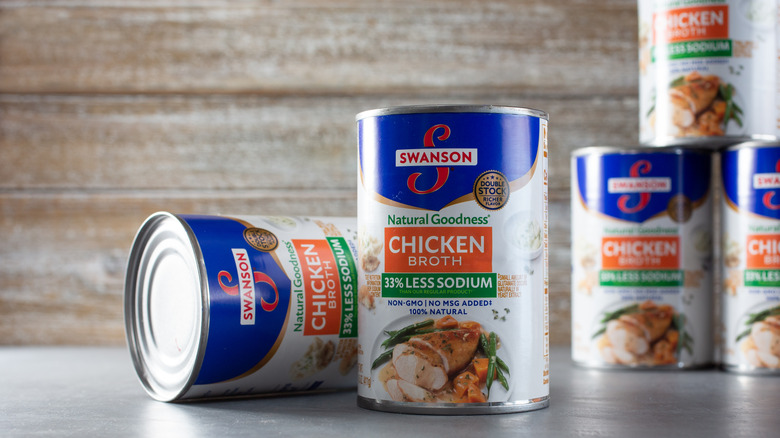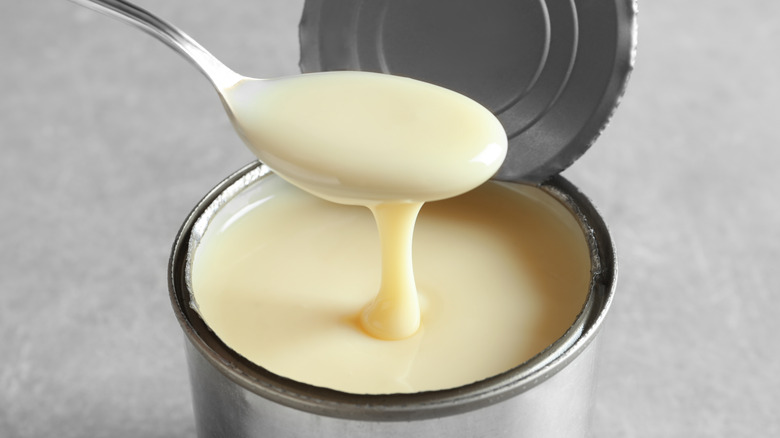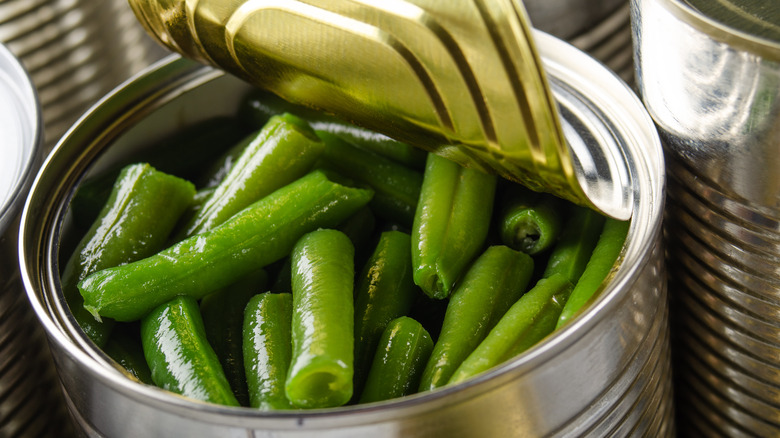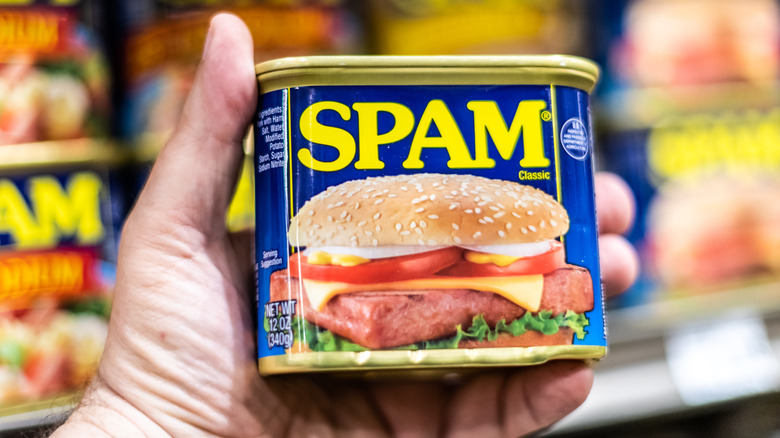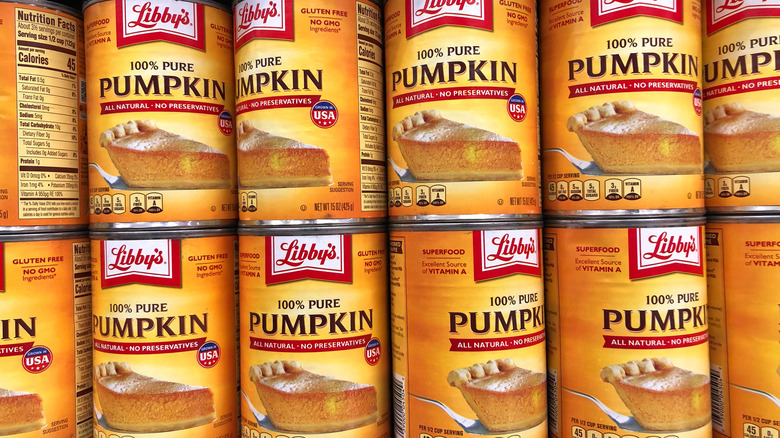13 Of The Most Popular Canned Foods In The US
Canning is a process that dates back to the early 19th century. Home canning was innovative as a practical means of food preservation in a time before refrigeration, and industrial canning has its roots in developing non-perishable military rations. But the 19th century's canning phenomenon sparked a surge towards convenience cooking among the civilian populace too, thanks to the introduction of shelf stable foods that made for efficient meals.
In the United States, the most popular canned foods coincide with much of America's history. Some of the first brands to lead the commercial canned food industry remain favorites today, and many popular canned foods in the US remain among the most widely consumed due to successful advertising campaigns of the early 20th century. Americans stock their pantries with these popular canned foods to keep them on hand as holiday staples, ready-to-go ingredients, and meals. Many of them are enjoyed for their nostalgia as much as their practicality, and their continued use reflects the ways in which America's taste has evolved with culinary conveniences.
1. Tuna
Tuna wasn't popular with Americans from the start. It wasn't until the early 1900s that it began to find a place in American pantries, but then only because a bad fishing season had limited the sardines that Americans formerly preferred. Tuna, at the time, wasn't considered any better than pet food, but a massive advertising campaign promoting its mild flavor as the "chicken of the sea" succeeded in convincing the American public to give it a try.
Whether it was tuna's lack of fishy flavor or general adaptability in a variety of dishes, Americans have certainly developed a taste for it. Tuna is today one of the most widely-consumed types of fish in the United States and has always been available in a can. Popularly mixed with some mayo and seasonings to make a quick tuna sandwich or baked into a good ol' tuna casserole, canned tuna is a pantry staple many Americans keep on hand for fixing up quick meals.
2. Applesauce
Applesauce is an ingredient popular in many American pantries for its diverse uses. Many enjoy it plain as a snack, side, or topping, but it has a place of prominence in both savory and sweet dishes, such as the traditional pairing of applesauce and pork. Many Americans have the habit of keeping canned applesauce on hand beyond being a versatile ingredient, as it is also a useful home remedy — reputed to be easy to digest, applesauce is a gentle antidote for an upset stomach.
Applesauce has in more recent years become an even more valued pantry staple because of the wonders it performs in various types of baking. While it makes for an innovative addition to apple pie and other typically apple-centric desserts, it has also proven to be an indispensable replacement in alternative baking. Applesauce's consistency and pectin content add a refined texture and structure to vegan, gluten free, and low-fat baked goods, serving as a binder that is a viable substitute for eggs, oil, or gluten in more traditional recipes. This use for applesauce may be one of many reasons why Market Data Forecast predicts that the North American applesauce market will only to continue to grow in the coming years.
3. Baked beans
Baked beans have long been a staple in North America. They played a significant role in Native American cuisine before they ever met the pairing of molasses that made them into the sweet and smoky dish we know today. The beans and molasses combo got its start in colonial Boston, which was a significant point on the map for the triangle trade system of the era. With an abundance of molasses that came from the refining of sugarcane shipped from the West Indies, Bostonians found creative uses for this byproduct; mixing it with beans was a use that persists to this day, hence the moniker Boston baked beans.
During the 19th century, this simultaneously sweet and savory duo went on to become a dietary staple for cowboys in the old west, because dried beans and molasses were two things that kept well and were easy to carry during long rides. Easy as these ingredients were to transport, however, they were still time-consuming to prepare. Canned baked beans offering the same taste with the benefit of being instantly eatable, were thus a culinary game changer when the HJ Heinz Company first mass-produced them in the 1890s. Thanks to this innovation, the dish became popular across the country and is still often associated with the communal dining that was the cowboy way, making regular appearances at barbecues and potlucks. Next time you want to wow your friends, try one of these tasty ways to elevate store-bought baked beans.
4. Tomato sauce
Tomatoes are another ingredient that took a while to become a regular food source amongst Americans. Prior to the 19th century, many still subscribed to the idea that they were poisonous. Overcoming this suspicion to gradually incorporate tomatoes into their diets, Americans started using them more with the introduction of canned tomato products to grocery stores. This was largely popularized by Campbell's tomato and tomato soup products, which became mainstream pantry staples at the turn of the 20th century.
Since then, canned tomatoes have become a true pantry staple in American cupboards, used weekly — even daily — by many households for making soups, sauces, curries, and more. Shelf stable, cheaper than fresh, and far less mess and hassle to prepare, canned tomatoes are in many ways a convenience food, but also happen to have a nutritional advantage over fresh tomatoes. This is because the antioxidant lycopene, which makes tomatoes red, is activated and more easily absorbable when heated, a process which automatically occurs when tomatoes are processed for canning. Though this may not be the initial reason many Americans keep canned tomatoes in the pantry, it's just another reason to keep doing so.
5. Cream of mushroom soup
Getting its start as another Campbell's product, condensed cream of mushroom soup was introduced to American households in 1934. Hitting the market in the middle of the Great Depression, this convenience food went a long way. The "condensed" moniker enabled canned soups to be sold for a lower price, and adding liquid to the concentrated canned contents increased the soup's volume to stretch a meal further. While the soup has, in essence, always been ready to eat from the can once diluted, it has largely maintained its popularity over the years because of its secondary purpose — when undiluted, cream of mushroom soup is an adaptable base for sauces and stocks too.
Condensed cream of mushroom soup has become a shortcut to savory gravies and other sauces, à la crème and beyond. But its most popular use as a sauce arose in the 1950s, again due to Campbell's innovations, when one of the enterprise's home economists, Dorcas Reilly, used it as the base for her savory holiday recipe, the green bean casserole. Now a Thanksgiving tradition and must-have for many holiday tables, this dish has ensured condensed cream of mushroom soup, available today from many different brands, is another American pantry staple.
6. Cranberry sauce
Cranberries are a fruit native to North America, and have been enjoyed for centuries. Their use as a sauce specifically paired with meat dates back to at least the colonial era; since then, cranberry sauce with turkey has become an infallible American tradition on Thanksgiving. Canned cranberry sauce, by comparison, is a more recent innovation, and came to be as a means of prolonging access to cranberries year-round. The brainchild of Marcus Urann, a lawyer who made the career shift towards cranberry growing in the early 20th century, canned cranberry sauce was first available to Americans in 1912 under the brand name Ocean Spray.
Though on grocery shelves year-round, canned cranberry sauce may be something Americans mostly store for the purposes of serving during Thanksgiving dinner, and it's a unique canned product with an almost cult following. Many Americans admit to preferring the canned version over fresh homemade cranberry sauce. The blob of ruby red plopped on a tray and sliced into circles elicits a certain nostalgia with its jellied and reliably uniform consistency. Beloved and bizarre, canned cranberry sauce has become a nostalgic pantry staple that really isn't popular — let alone available — anywhere else.
7. Chicken broth
While canned chicken soup is indeed another American pantry favorite for a shelf-stable ready-to-eat meal, canned chicken broth is perhaps even more often stored in cupboards. A few cans of chicken broth is a must for many households, because it's the ready-made base to a quick, savory, and wholesome meal. It transforms a potful of ingredients into practically any pottage recipe out there, but also adds a whole new dimension to risottos and sauces as well.
For many American home cooks, canned chicken broth is a no-brainer, the happy medium between canned ready-to-eat soup and recipes truly made from scratch. Making chicken broth from scratch involves a time-consuming process of boiling leftover chicken bones and trimmings for hours, and there's many ways you can mess it up. Comparatively, in terms of convenience, canned chicken broth can't be beat, and it has revolutionized the realm of home cooking as an efficient way to boost a meal's flavor, inspiring meals that are still made from fresh ingredients with a base that's ready to go.
8. Corn
While canned corn often comes out for Thanksgiving and shines as a star ingredient in the fall, it is another canned favorite enjoyed year-round. Corn has been an American staple for thousands of years. Though the bright golden variety most recognizable today looks a lot different from the varieties Native Americans cultivated and introduced to the first American colonists, corn has always been among Americans' favorite vegetables. According to Green Giant's most recent annual survey of America's favorite veggies, corn, in 2023, was the No. 1 favorite vegetable, beating broccoli, which was formerly the perennial favorite.
Canned corn is often kept on hand because it is a convenient form that requires little to no additional preparation. Pre-shucked and sliced and no less sweet than fresh, canned corn is a serving of instant gratification and a colorful addition to soups, salads, dips, and casseroles, among many other dishes.
9. Condensed milk
Sweetened condensed milk was introduced to American households in 1853 as a solution to a national dairy craving that posed many health risks in a time before refrigeration. But while originally intended as a milk substitute, canned sweetened condensed milk has evolved to become a unique ingredient in its own right, opening up the possibilities for entirely new kinds of foods. While condensed milk has gone on to become a popular item worldwide in places that don't otherwise have the same access to fresh milk, it remains a staple in cupboards across the US.
Well-suited to sweet things and often used directly as a sweetener itself, canned condensed milk is a prime baking ingredient. Condensed milk is key to upgrading boxed cake mix, as its thick consistency adds depth to baked goods, promising moisture without being too liquidy. Ideal for all things creamy and custardy, sweetened condensed milk has become a significant ingredient in many Latin American desserts, such as flan and tres leches cakes.
10. Green beans
Convenient and quick to cook, canned green beans are an easy go-to for many American households. Another exceptional vegetable that's adapted well to canning, they are also among the top-consumed vegetables in the US, and add a quick burst of green to any meal. Canned green beans are usually prepared as a side dish and can be eaten plain or jazzed up ingredients like garlic or bacon. But canned green beans are also highly adaptable as an addition to anything savory and often find their way into soups and salads too.
The holiday season has become a grand occasion for this canned veggie, as it's a shortcut to whipping up the evergreen Thanksgiving green bean casserole. Incidentally, this popular dish was a Campbell's invention made for the express purpose of showing off what canned ingredients were capable of. Resulting from the success of this dish, green bean casserole has become a comforting American holiday tradition for many, and ensured that a few cans of green beans are readily available in cupboards across the country.
11. SPAM
SPAM's invention and popularity in the US is inextricably linked with WWII. Getting its start in the late 1930s as an innovative protein source that could make for convenient meals, SPAM found its niche with the US military soon after. The mixture of pork and potato starch was invaluable to the American GIs stationed overseas, particularly those in the Pacific, as SPAM, which requires no refrigeration, was an efficient protein source in tropical climates.
During the war and its aftermath, SPAM was introduced to civilians on the Pacific front and adopted into local dishes; it found lasting success in both Japanese and Korean cuisine and solidified its international presence. But SPAM remained a fixture on the home front too. While it may have been reduced to an occasional sandwich meat across the contiguous US, WWII sparked SPAM's popularity in Hawaii, because wartime restrictions transformed SPAM into a necessity. It became the go-to meat source because it was plentiful, readily available, and kept well in tropical heat. This ingredient born out of wartime necessity has since been transformed into some emblematic SPAM-centric Hawaiian dishes, such as loco moco and spam musubi.
12. Peaches
The wide availability of canned peaches in the US may tie in with their popularity throughout the 20th century amongst American soldiers overseas; the servicemen favored peaches as a sweet ambrosia over the rest of their often bland war rations. Store-bought canned peaches are today one of the most popular canned fruits in the US, as they are one example of preserved fruit that is well-suited to canning — a great number of Americans enjoy them just as much or even more than their fresh counterparts.
Many enjoy eating canned peaches plain and straight from the can, as they are conveniently pre-washed, peeled, and sliced. They are a sweet, colorful addition to salads and sauces too. But canned peaches are also a pantry staple in many American households because they are the fundamental ingredient in many traditional American desserts, such as a simple and delicious peach crisp.
13. Pumpkin puree
Pumpkin puree is another pantry staple with uniquely American appeal, because it is often safeguarded for whipping up the iconic pumpkin pie once Thanksgiving rolls around. To many people making their pumpkin pies "from scratch," canned pumpkin puree saves a great deal of time and energy, as raw pumpkin is very difficult to peel, cook, and blend to the proper consistency.
While those who live for the season of pumpkin spice probably have jars of pumpkin puree on hand for other pumpkin-centric recipes, many American keep it on hand for purposes completely independent of the holiday season. Sticking to the baking section of the pantry, pumpkin puree has also been getting attention as an alternative baking innovation for its effectiveness as an underrated egg substitute. Capable of adding both structure and moisture to baked goods, ¼ cup goes a long way, capably replacing eggs in most recipes without imposing unwanted pumpkin flavor.
